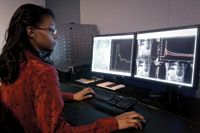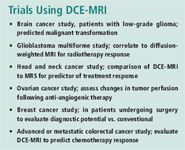Imaging as Biomarkers
Novel methods hold promise in making clinical trials more efficient and affordable.
Medical imaging is employed in all phases of new drug development. Imaging can guide the diagnosis, treatment, and management of disease and serve as biomarkers for prognosis, progression, and outcomes.

PHOTO: COURTESY OF ACR IMAGEMETRIX
Whereas traditional imaging methods are largely directed at obtaining anatomical information, functional (i.e., molecular or mechanistic) imaging quantifies real-time physiologic and metabolic processes at the cellular or molecular level. These novel imaging techniques have become attractive biomarkers in clinical trials. Through early determination of drug efficacy, functional imaging techniques promote efficient decision-making in clinical trials, saving time and money.
Magnetic Resonance Spectroscopy (MRS) and Dynamic Contrast-Enhanced Magnetic Resonance Imaging (DCE-MRI) are functional imaging techniques increasingly used in clinical trials. MRS generates spatially localizable biochemical information from tissues. DCE-MRI is a perfusion-based technique that evaluates tissue vascularity. However, the use of MRS/DCE-MRI imaging endpoints as in vivo biomarkers requires imaging studies to produce reliable quantitative, semi-quantitative, and qualitative results that can be used to assess disease status.
Ensuring such consistency in multicenter clinical trials that involve imaging is problematic because data acquisition and reconstruction are performed in many different settings and often with different types of instrumentation.
Applications in clinical trials
MRS complements MRI as a noninvasive means for the characterization of tissue metabolism. While MRI uses the signal from hydrogen protons to form anatomic images, MRS uses this information to produce a unique biochemical signature for the metabolite constituents of different tissues. Although proton MRS has been applied in a wide range of biomedical investigations, there is a growing interest in utilizing multinuclear spectroscopy (i.e., 31P and 13C) to extend the clinical applications of MRS even further. Herein, we focus on the applications of proton MRS in clinical trials

Trials Using DCE-MRI
The biochemical profile of a tissue of interest acquired by MRS is called spectrum. MRS spectrum represents a graph of a group of peaks where each peak reflects a chemical compound denoted in parts-per-million (ppm) on the x-axis with concentration indicated by peak height. Computer software programs using analytical methods and mathematical formulas calculate the relative concentration of detected metabolites in healthy and pathological states.1
In a typical brain proton spectrum, the water peak appears at 4.7 ppm, while fat peaks appear at 0.9, 1.3, 3.2, and 5.2 ppm. N-acetyl aspartate (NAA) peaks in healthy brain tissue at 2.02 ppm, with a decreased peak in brain pathology. Total choline, an indicator of membrane synthesis and cellular proliferation, peaks at 3.22 ppm. While an increased choline peak is found in most malignant tumors, decreasing choline may reflect changes related to anti-tumoral treatment. MRS has been used to investigate several diseases, including cancer, epilepsy, Alzheimer's, Parkinson's, and Huntington's chorea.1
Although its main current application consists of proton MRS in the brain, there is a growing interest in using MRS for understanding disease states in the prostate, liver, muscle, breast, and heart.1 For example, MRS has shown to be an effective tool in Fatty Liver Disease (FLD) evaluation. FLD is the most common cause of chronic liver disease in the United States. Risk factors include obesity, diabetes, alcoholism, and drug toxicity.2 Because liver biopsy, currently the gold standard for measuring liver fat, is invasive, prone to sampling errors, and inappropriate in some settings, MR-based techniques are attractive alternatives for evaluating hepatic fat.3 MRS in particular is a promising functional imaging method commonly utilized in clinical trials involving FLD.
MRS proved to be a sensitive method for measuring hepatic triglyceride content (HTGC) in 2349 Dallas Heart Study participants.4 Using MRS to measure hepatic fat, a lifestyle intervention study in 50 adults with nonalcoholic FLD (NAFLD) concluded that improved aerobic fitness is an independent predictor of reduced liver fat.5 In a study evaluating a novel method of MRS (i.e., the HISTO sequence), researchers found that the new sequence reliably measured hepatic lipid levels.6
A current National Institute of Health study will compare MRS-measured HTGC with liver biopsy results in 70 adults. A Washington University study will analyze the reproducibility of pre- and postprandial HTGC obtained via modified MRS sequence in patients with NAFLD.
More conventional MR imaging appears to correlate highly with MRS measurements and may be easier to implement in trials. Liver fat fractions determined using a new MRI acquisition sequence correlated highly with MRS results in 37 diabetic adults.7 Another study determined in-phase and out-of-phase MRI for rapid liver fat estimation was as accurate as MRS in 33 diabetic adults at risk for NAFLD.8
Clinical trials involving several other diseases, especially various cancers, have utilized MRS. A recent American College of Radiology Imaging Network (ACRIN) trial compared MRI and MRS, as well as the combination of both for prostate cancer detection prior to radical prostatectomy.9 ACRIN is also investigating MRS-measured total choline as a marker of pathologic response in Stage III breast cancer patients who have had an incomplete response to neoadjuvant chemotherapy.
A randomized ACRIN drug trial (bevacizumab with temozolomide) will use MRS and DCE-MRI to stage adults with recurrent brain cancer (i.e., intracranial glioblastoma or gliosarcoma) then assess agreement between local and central imaging interpretation. The same trial will also evaluate MRS and DCE-MRI as prognostic biomarkers based on serial imaging results.
Despite promising results in research applications, there are significant challenges to using MRS in a trial. It requires verification of imaging instrument performance, standardization of image acquisition protocols, development of an on-site training program, and development of reliable data management and data mining procedures. While these requirements discourage the routine clinical use of MRS, for certain drug development trials the effort may prove worthwhile. Because measurable anatomical impact of drug therapy lags behind MRS changes, the unique biochemical information from MRS can promote earlier decision-making with respect to the viability of an investigative agent.
DCE-MRI use in trials
DCE-MRI tracks the diffusion of an intravascularly administered paramagnetic contrast agent (i.e., gadolinium) into the extravascular tissue over time. As the mean contrast agent concentration within a volume of tissue (i.e., a "voxel") increases, its signal intensity increases. Using mathematical algorithms and compartmental modeling, this relative signal increase is converted into a quantitative measure of contrast agent over time. The volume of blood vessels in the voxel, the rate of flow, and the rate of diffusion are the principle determinants of the outcome measure of DCE-MRI, (Ktrans). Because of how rapidly these processes occur, DCE-MRI requires more rapid image acquisition than conventional MRI (i.e., every 2 to 10 seconds vs. 30 seconds to several minutes).10
Immature blood vessels seen in cancers are highly permeable to gadolinium-based contrast agents. Because tumors elicit angiogenic factors to spur new blood vessel growth, anti-angiogenic and vascular destructive agents can be effective anti-tumor therapies, particularly in combination with other drugs.
During vascular-targeted therapy trials, DCE-MRI can measure vascular responsiveness to the study drug. As vascular changes precede tumor shrinkage, DCE-MRI allows earlier assessment of drug efficacy and treatment response than is possible with traditional anatomic measurements.10 Therefore, as the number of anti-angiongenic agents is rapidly growing in various phases of clinical trials, one must conclude that DCE-MRI has a promising future in drug development.
As a novel imaging approach, DCE-MRI provides insight into the tumor microenvironment (e.g., vessel permeability, perfusion, extracellular-extravascular volume fraction). As such, the technique can define a drug's mechanism of action and measure its pharmacodynamics. Although not yet accepted as a marker for registrational trials, DCE-MRI results ultimately may serve as predictive biomarkers of clinical outcomes, such as treatment response and progression-free survival.10
Targeted therapeutic areas
DCE-MRI has been used extensively in oncology trials. A recent prospective study in 13 brain cancer patients with low-grade glioma found that changes on serial DCE-MRI predicted malignant transformation. Increased relative cerebral blood volume on DCE-MRI preceded evidence of malignancy on standard MRI (i.e., contrast enhancement on T1-weighted images).14 A current study at Yale will correlate DCE-MRI and diffusion-weighted MRI results with histopathologic findings and clinical response to radiotherapy in patients with glioblastoma multiforme.
Researchers also are analyzing DCE-MRI results as predictors of treatment response. One study in head and neck cancer patients at Memorial Sloan-Kettering Cancer Center (MSKCC) will compare DCE-MRI and MRS to clinical markers as predictors of treatment response to neoadjuvant chemotherapy for osteogenic sarcoma and Ewing's sarcoma. In particular, the trial will investigate whether preoperative and/or early treatment DCE-MRI results predict treatment response (i.e., tumor necrosis and disease-free survival) compared to clinical and molecular parameters. An ovarian cancer study at MSKCC is using a novel DCE-MRI analysis method (with and without motion correction) to assess changes in tumor perfusion following anti-angiogenic therapy.
A National Cancer Institute (NCI) study in breast cancer patients undergoing surgery will evaluate the diagnostic potential of DCE-MRI and MRS compared to conventional findings from mammography, tissue proteomics, and histopathology. A randomized Phase II NCI-sponsored trial in patients with advanced or metastatic colorectal cancer will correlate drug-induced tumor vascular changes with clinical biomarkers to evaluate DCE-MRI as a predictor of response to chemotherapy (FOLFOX alone vs. FOLFOX plus bevacizumab at 5 or 10mg/kg).
Investigating chemotherapy (FOLFOX plus bevacizumab) response in metastatic colorectal cancer patients, an ACRIN trial will evaluate a new DCE-MRI acquisition method and compare drug-induced tumor vascular changes to clinical indicators of treatment response.
Several kidney cancer trials using DCE-MRI are underway. A randomized Phase II trial in patients with advanced renal cell carcinoma will use DCE-MRI to assess tumor vascular changes following chemo (bevacizumab alone vs. bevacizumab plus interferon alpha-2a) and correlate them with clinical and imaging outcomes, including change in tumor size and progression-free survival. Another trial involving targeted combination chemotherapy (VEGF, RAF kinase, mTOR, and EGF-R) will also evaluate DCE-MRI results as a biomarker for efficacy.
Researchers are using DCE-MRI to study prostate cancer. In one study, DCE-MRI parameters are being compared with laboratory markers and histopathologic (biopsy) results in prostate cancer patients. A Washington University study is evaluating the accuracy of prostate cancer detection using different types of MR-based imaging (including DCE-MRI and MRS). The trial will compare pretreatment imaging to histopathological findings in surgical specimens (from radical prostatectomy) and biopsies (obtained during radiotherapy).
National Taiwan University Hospital is analyzing DCE-MRI results as a biomarker for treatment response in a Phase II study of radiotherapy for locally advanced hepatocellular carcinoma. Pretreatment DCE-MRI will be compared to subsequent imaging studies to correlate tumor perfusion changes with disease progression and other clinical outcomes.
Successful DCE-MRI integration in a trial requires careful orchestration. Imaging at such rapid rates with existing MRI equipment affects image quality, resolution, and anatomical coverage. When technologists and radiologists are not familiar with DCE-MRI, careful training is essential to obtain high-quality images. Patient selection, the tumor mass chosen as the region of interest (ROI), and imaging plane all affect image quality. Furthermore, to assess exam reproducibility, most protocols include pretreatment test-retest procedures to ensure similar levels of contrast accumulation. While some therapies take days or weeks to reach peak anti-angiogenic effect, others take effect hours after administration. Considering the need for test-retest visits and variable drug timetables, the ideal DCE-MRI schedule differs for each trial.10
Summary
Mechanistic imaging techniques, including MRS and DCE-MRI, have a promising future as biomarkers in clinical trials. Considerable expertise, precise site training, and strict quality assurance are necessary to design and administer effective protocols using functional imaging. Yet novel imaging methods, which for many conditions and investigative agents may determine drug efficacy faster than standard clinical parameters, can make clinical trials more efficient and cost-effective.
An established imaging CRO with the capability to provide high-quality functional image quantitation can smoothly integrate novel imaging methods into a clinical trial. A comprehensive approach and standardized operating procedures ensure the normalization of quantitative data across multiple sites. Centralized image management—from acquisition through interpretation—is essential in multicenter trials. The strengths of an imaging CRO pave the way for seamless implementation of functional imaging methods, such as MRS and DCE-MRI, in clinical trials.
Mehdi Adineh, PhD is Scientific Director at ACR ImageMetrix, 1818 Market Street, Suite 1600, Philadelphia, PA 19103, email: madineh@acr-arrs.org.
References
1. H. Poptani, "Magnetic Resonance Spectroscopy (MRS) for Measurement of Hepatic Fat," White Paper in library section under Scientific Showcase on Web site www.acr-imagemetrix.net.
2. B. Taouli, R. Ehman, S. Reeder, "Advanced MRI Methods for Assessment of Chronic Liver Disease," American Journal of Roentgenology, 193:14-27 (2009).
3. F. Hughes Cassidy, T. Yokoo et al., "Fatty Liver Disease: MR Imaging Techniques for the Detection and Quantification of Liver Steatosis," RadioGraphics, 29, 231-260 (2009).
4. L. Szczepaniak, P. Nurenberg et al., "Magnetic Resonance Spectroscopy to Measure Hepatic Triglyceride Content: Prevalence of Hepatic Steatosis in the General Population," American Journal of Physiology—Endocrinology and Metabolism, 288, E462-E468 (2005).
5. K. Kantartzis, C. Thamer et al., "High Cardiorespiratory Fitness is an Independent Predictor of the Reduction in Liver Fat During a Lifestyle Intervention in Non-alcoholic Fatty Liver Disease," Gut, 58, 1281-1288 (2009).
6. N. Pineda, P. Sharma et al., "Measurement of Hepatic Lipid: High-Speed T2-Corrected Multiecho Acquisition at 1H MR Spectroscopy—A Rapid and Accurate Technique," Radiology, 252, 568-576 (2009).
7. B. Guiu, J.M. Petit et al., "Quantification of Liver Fat Content: Comparison of Triple-Echo Chemical Shift Gradient-Echo Imaging and in Vivo Proton MR Spectroscopy," Radiology, 250, 95-102 (2009).
8. R. Borra, S. Salo et al., "Nonalcoholic Fatty Liver Disease: Rapid Evaluation of Liver Fat Content with In-Phase and Out-of-Phase MR Imaging," Radiology, 250, 130-136 (2009).
9. J. Weinreb, J. Blume et al., "Sextant Localization at MR Imaging and MR Spectroscopic Imaging before Prostatectomy: Result of ACRIN Prospective Multi-institutional Clinicopathologic Study," Radiology, 251, 122-133 (2009).
10. M. Rosen, "Dynamic Contrast Enhanced MRI (DCE-MRI) in Drug Development," White Paper in library section under Scientific Showcase on Web site www.acr-imagemetrix.net.
Additional resources
1. N. Danchaivijitr, A. Waldman et al., "Low-Grade Gliomas: Do Changes in rCBV Measurements at Longitudinal Perfusion-weighted MR Imaging Predict Malignant Transformation?" Radiology, 247, 170-178 (2008).
2. C. Roberts, G. Parker et al., "Glandular Function in Sjögren Syndrome: Assessment with Dynamic Contrast-enhanced MR Imaging and Tracer Kinetic Modeling—Initial Experience," Radiology, 246, 845-853 (2008).
3. K. Horsthuis, C. Lavini et al., "Perianal Crohn Disease: Evaluation of Dynamic Contrast-Enhanced MR Imaging as an Indicator of Disease Activity," Radiology, 251, 380-387 (2009).
4. S. Taylor, S. Punwani et al., "Mural Crohn Disease: Correlation of Dynamic Contrast-Enhanced MR Imaging Findings with Angiogenesis and Inflammation at Histologic Examination—Pilot Study," Radiology, 251, 369-379 (2009).
Newsletter
Stay current in clinical research with Applied Clinical Trials, providing expert insights, regulatory updates, and practical strategies for successful clinical trial design and execution.
Unifying Industry to Better Understand GCP Guidance
May 7th 2025In this episode of the Applied Clinical Trials Podcast, David Nickerson, head of clinical quality management at EMD Serono; and Arlene Lee, director of product management, data quality & risk management solutions at Medidata, discuss the newest ICH E6(R3) GCP guidelines as well as how TransCelerate and ACRO have partnered to help stakeholders better acclimate to these guidelines.
